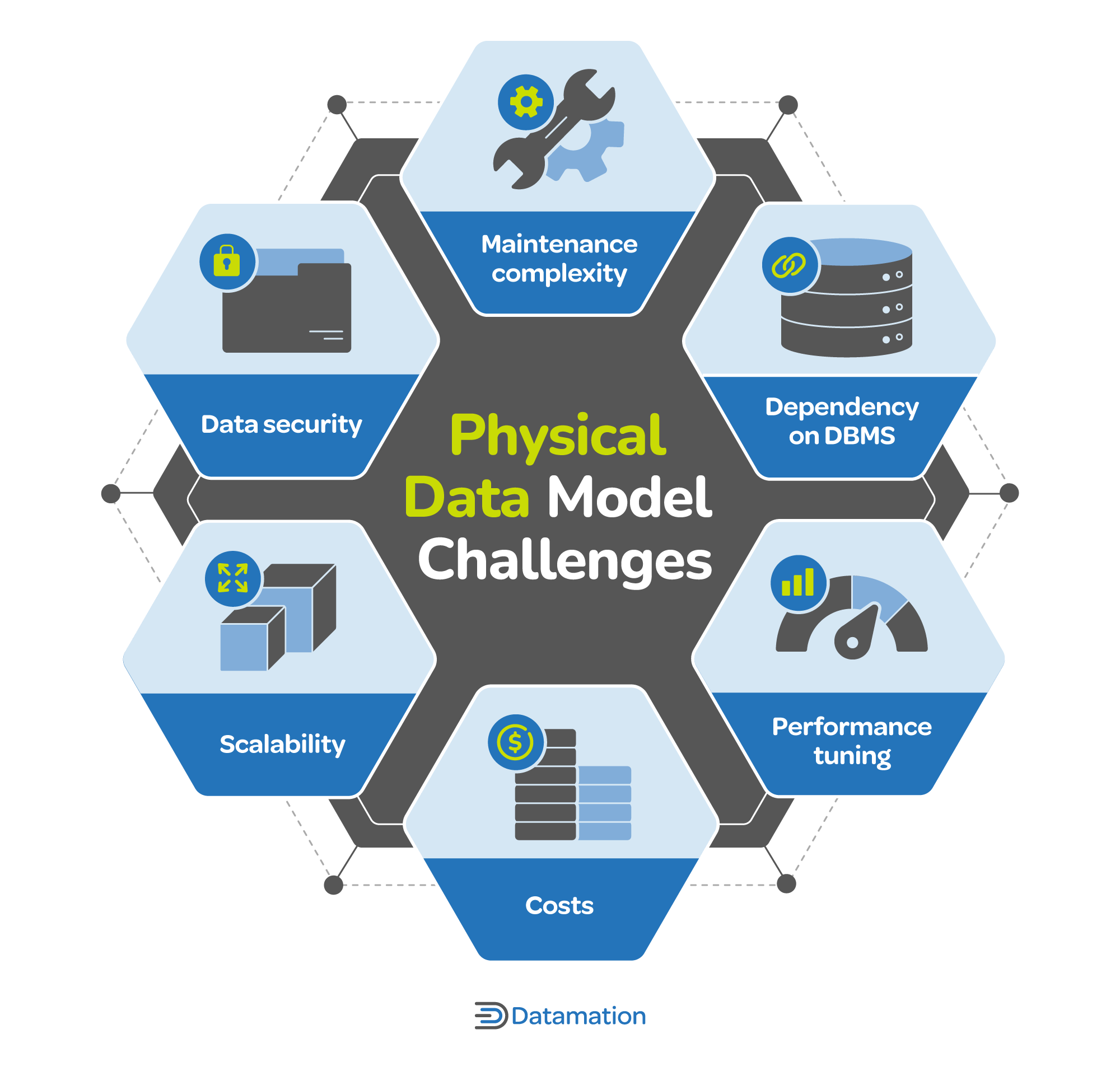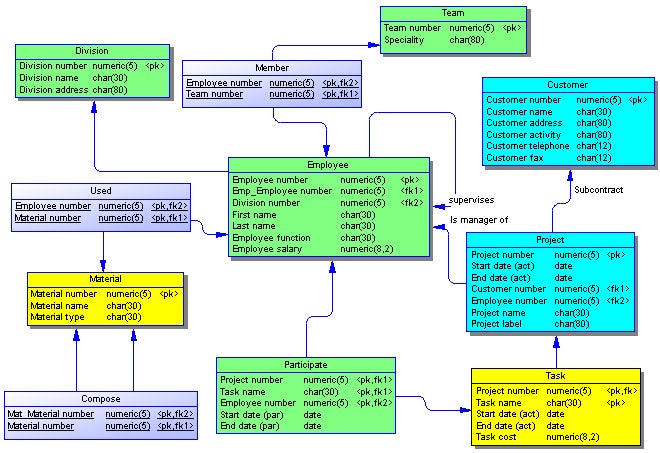
A physical data model represents the structure of a database, defining how data is stored, organized, and accessed at the physical level. It provides a detailed view of the database schema, specifying tables, columns, data types, relationships, indexes, and constraints. As such, the physical data model (PDM) serves as a framework to guide developers in creating and optimizing the actual database, taking into account storage considerations, performance improvement, and specific features of the database management system (DBMS).
A physical data model transforms broad business requirements into a specific, well-organized database structure tailored to the capabilities of the DBMS for which it is designed. By outlining the details of how to organize and store data, the PDM ensures efficient data storage and smooth system operation for tasks such as information retrieval and transaction handling.
Physical data models encompass critical details such as data types, indices, and constraints, serving as a comprehensive guide for implementing the database.
The PDM facilitates the conversion of entity types to tables and attributes to columns identified in the logical data model. This includes establishing primary keys (PK)—which uniquely identify each record in a table—and determining foreign keys (FK), which establish relationships between tables by linking to the primary key of another table, as shown in the diagram below.

Fig. 1 – Physical Data Model Diagram (Source: GIS&T Body of Knowledge)
The PDM makes sure that the database aligns with the business needs, translating conceptual ideas into a tangible and functional structure. Physical data models also address the technical aspects of database implementation, unlike logical data models, which focus on the high-level, business-oriented view of data.
Table design, normalization, indexing, data types, and concurrency control are some of the fundamental techniques that form the core of physical data modeling. They bring a solid foundation for designing efficient and maintainable databases capable of meeting data integrity and performance requirements.
Conceptual, logical, and physical data models represent distinct yet interrelated stages of the database system development process. Each stage serves a specific purpose. It’s worth noting that these three models are not directly comparable—rather, they represent progressive stages in the database design process, as follows:
When used in the right scenarios, physical data models offer a wide range of benefits. Here are some of the most common advantages.
Because a physical data model specifies the structure of tables, data types, and lengths, increasing data storage efficiency, it helps guarantee that the database consumes space wisely, reducing unnecessary overhead.
By strategically implementing indexes, partitioning large tables, and clustering related data, physical data models boost database performance. These adjustments expedite data retrieval, resulting in faster query execution times and better system responsiveness.
In physical data models, integrity constraints such as primary keys, unique constraints, and foreign keys are implemented. These constraints help safeguard data accuracy and reliability stored in the database and prevent anomalies.
The PDM allows for the effective partitioning of large tables, enabling the database to handle a growing volume of data while maintaining performance. It streamlines data management and scales as data requirements increase.
By employing strategies such as thoughtful indexing and well-planned design choices, physical data models accelerate data retrieval, contributing to an overall enhancement in the effectiveness of database queries.
The PDM acts as a visual aid, helping developers, administrators, and business users understand the database design more easily. It fosters effective communication and shared comprehension of how data is structured and organized.
Normalization techniques used in the PDM break down tables into smaller, related components, minimizing redundancy. This leads to a simplified and consistent data representation within the database.
Since physical data models align with the specific features and capabilities of the DBMS environment, it secures optimal utilization of system resources within the chosen technology stack.

While physical data models bring a myriad of benefits, they also come with their own set of challenges. Addressing these challenges requires a combination of technical expertise, careful planning, and ongoing collaboration between stakeholders involved in the database management process. Here’s a look at some common challenges associated with physical data models.
Physical data models can become complex, particularly in large and evolving databases, making routine maintenance tasks challenging. Altering structures and adjusting indexes may require careful planning and execution.
The PDM is often closely tied to a specific DBMS, and substantial modifications are necessary when transitioning to a different DBMS. This limits adaptability and poses challenges during technology changes.
Balancing optimization in a physical data model is tricky because it involves finding the right trade-offs to make sure the database performs well for different operations, like reading and writing data. Striking this balance is intricate and may not always yield optimal results for all use cases.
Maintaining data security is crucial to protect sensitive information in physical data models. However, providing accessibility for authorized users with stringent safeguards against unauthorized access involves careful consideration of encryption, access permissions, and overall security measures, which is complex.
Scaling a database with a complicated PDM can be difficult. Accommodating the growth of data and user load may require adjustments to hardware, partitioning strategies, and overall system architecture.
Costs present a multifaceted challenge in physical data models, covering initial implementation, ongoing maintenance, and scalability efforts. Upfront expenses include hardware, software licensing, and expertise for database setup. Infrastructure costs for servers, storage, and networking, as well as ongoing maintenance tasks, contribute to operational expenses. On top of that, scaling to accommodate data growth and employing data security tools incurs supplementary costs.
 Fig. 2 – Physical Data Model Diagram (Source: SAP Sysbase Infocenter)
Fig. 2 – Physical Data Model Diagram (Source: SAP Sysbase Infocenter)
Physical data models contribute to the effective implementation of database systems when used in the right applications, ensuring that they meet the specific requirements of diverse industries. Here are some of the most common use cases.
Companies can use physical data models when upgrading their customer relationship management (CRM) systems, designing an optimized database schema and defining tables, relationships, and constraints. This ensures smooth data storage and retrieval, considering factors like indexing and data types.
Physical data models are used in designing data warehouses to consolidate and analyze data from multiple sources for business intelligence. This entails specifying how data is stored, organized, and accessed, refining the structure for complex analytical queries.
e-Commerce platforms use physical data models in building the database architecture for product catalogs, user profiles, order processing, and recommendations. For example, an index created on the “ProductID” column of the “Products” table could speed up searches when customers are looking for a specific product, enabling a seamless shopping experience.
In a large financial database, partitioning based on date ranges could be implemented for a “Transactions” table to improve query performance and make it easier to manage and maintain historical data.
Physical data models are the nuts and bolts that support database performance and keep data secure. By organizing data at the physical level, they minimize redundancy and maximize efficiency in accessing and manipulating information. Recognizing the importance of physical data models is key to building resilient and high-performing database systems.
Understanding how a PDM works can help you harness its inherent benefits and shed light on the challenges that you may encounter in its implementation. A well-crafted PDM can help you achieve optimal database performance, data security, and overall information management success, setting the stage for adapting to future challenges.
Logical data models serve as the conceptual blueprint that informs the design and structure of the physical data model, read our comprehensive article on logical data models to find out more.

Datamation is the leading industry resource for B2B data professionals and technology buyers. Datamation's focus is on providing insight into the latest trends and innovation in AI, data security, big data, and more, along with in-depth product recommendations and comparisons. More than 1.7M users gain insight and guidance from Datamation every year.
Advertise with TechnologyAdvice on Datamation and our other data and technology-focused platforms.
Advertise with Us
Property of TechnologyAdvice.
© 2025 TechnologyAdvice. All Rights Reserved
Advertiser Disclosure: Some of the products that appear on this
site are from companies from which TechnologyAdvice receives
compensation. This compensation may impact how and where products
appear on this site including, for example, the order in which
they appear. TechnologyAdvice does not include all companies
or all types of products available in the marketplace.